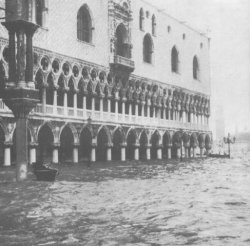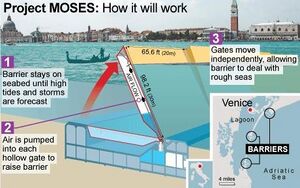Flood of 1966
On November 4, 1966 subject to an abnormal occurrence of both atypically high tides, rain-swollen rivers and a severe Sirocco wind, the Venice Lagoon overran and sent flood waters through the canals to a height of 6ft 4in. Recorded as the worst flood in the city’s history, thousands of residents were stuck in their homes for day; while various pieces of art valued at over $6 billion which was stored on ground floors were damaged. Venice, which was neglected and quietly deteriorating ever since the defeat of the Venetian Republic by Napoleon over a century and a half before, was suddenly recognized as a city in urgent need of restoration.[1]
Timeline of Events

This is the Doge's Palace in St. Mark's Square on 4 November 1966. It was flooded under 150 centimeters of sea water (194 centimeters when measured from the average sea level), and boats can be seen navigating the piazza. Three days of heavy rain brought Venice to its knees (and water up to its residents' shoulders). It was the same along rivers and lagoons in many Italian cities in Northern and Central Italy. Florence, Trento, Siena, and Venice were the most severely affected. Venice remained isolated for 24 hours, and the city was not at all prepared to face such an emergency. The streets in the historical center of Venice were flooded to average heights of more than 50 centimeters. On the nearby island of Pellestrina, more than 2000 people had to leave their houses, and more than 1200 residents abandoned Venice entirely. More than 75 percent of businesses, shops, and artisans' studios were seriously damaged, and thousands of goods were ruined or destroyed.[2]
Video
Watch a video of the aftermath caused by the flood of 1966 here.
Funding and Assistance
Funding and assistance flew in from all around the globe after the Flood of 1966 shed light on the depreciation of Venice's art and architecture. Funding was received from:
- United Nations Educational, Scientific and Cultural Organization (UNESCO)
- The Private Committees for the Safeguarding of Venice (ACP)
Conservation and Environmental Measures

While at first the Arno River’s Florentine destruction seemed more severe, it was Venice that demonstrated to be more difficult to conserve. John pope-Hennessy, a British art historian, detected that for the first time the full extent of the city’s problems was seen:
- “It was not just a matter of the flood; rather it was a matter of what the flood revealed, of the havoc wrought by generations of neglect. For centuries Venice lived off tourists, and almost none of the money they brought into the city was put back into the maintenance of its monuments. And that had been aggravated by problems of pollution, an issue of the utmost gravity.”'
In response, several national, along with international organizations, began working tirelessly in both Venice and Florence, making remarkable development in conserving countless individual sites. The most notable of organizations included UNESCO, Venice in Peril, Save Venice Inc and the World Monuments Fund. In the early sixteenth century Venice’s perilous physical situation was realized, when its doges tried to safeguard the lagoon city and its harbor by diverting rivers from the lagoon to prevent river silt from accumulating and blocking the lagoon. Despite these efforts, over the centuries as the mean sea level gradually rose and the foundations of many buildings settled further into the mudflats. The Venetians also gradually raised their islands, as verified by the deepest archaeological layer in St. Mark’s Square, which is located approximately 10 feet below the present pavement. Thus today's continuing flooding problem is worsened by an obsolete four-hundred-year old lagoon-dredging program and a sinking seabed.[3] In combination with measures such as coastal reinforcement, the raising of quaysides and paving and improvement of the lagoon environment, engineers at FIAT designed the MOSE Project. These gates are able to protect the city of Venice from extreme events such as floods and morphological degradation.[4]
See Also
- UNESCO
- Private Committees for the Safeguarding of Venice
- Save Venice Inc
- Venice in Peril
- World Monuments Fund
- MOSE Project
References
- ↑ "Venice: After the flood".
- ↑ http://www.veniceword.com/news/9/acqua.html
- ↑ "Architectural Conservation in Europe and the Americas".
- ↑ "MOSE Projet".